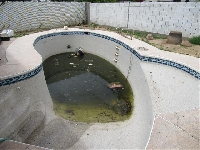
Keeping your swimming pool water clear may take some work. Get started!
The water in your swimming pool can get pretty (ugh!) disgusting looking at times. This happens to every pool owner, and when it does you’ve got to figure out how to clear the pool water.
Sometimes this involves trial and error, or you might get lucky and get it right the first time. Remember what you did, write it down, so you can use the same successful approach the next time your pool water looks hideously uninviting.
You’ve all seen green swimming pools and know that they’re going to turn your blonde hair a sickening shade of puce if you jump in. Green water, instead of blue, means that you need to run a serious pool shock. You do this by adding chlorine to the water. You need to put in a lot more than you normally do and maybe five times the amount.
Over the winter, contaminates collect in your pool. Contaminates can also collect after you have used the pool a lot, turning the water green. When you shock your pool, do it at night, rather than in the daytime, because the chlorine will dissolve quicker this way.
This should clear up your pool water in no time flat. When you shock your pool you are killing all organic contaminates, bacteria, and you are controlling the algae, which allows you to have clear, sparkling water instead of something that looks like it came out of the Black Lagoon.
~
When you apply chlorine to your water it gets rid of all the contaminants that are making the pool unsanitary and the water ghastly looking. When you have added enough chlorine, your pool will be continuously sanitized your pool. Your water should remain clear, clean and blue, as a result. A pool that has chlorine in it is a clean, sanitary pool.
If your pool is a normal color but cloudy this is caused by algae or because your filter system is inadequate and there is poor circulation in the pool. If you don’t use your pool very much this can also cause the water to cloud up.
Suntan lotion can turn your water cloudy and leave a slick film on the surface of the water. When a pool is in the shade, rather than in the sun, this increases the risk of cloudy water. Have you been spraying your lawn with fertilizer? If it drifts into the water, this clouds it up. When a pool is cloudy, milky and discolored you may want to check your filtration system and see if it is functioning properly. You can additionally add chlorine to the water and backwash the filter, which should help.
When pool parts or even the water become a rusty red color, this is an indication that the iron or steel in the pool have corroded and are rusting. You need to replace the parts.
Your pool will be the right color when you use the right balance of chemicals. The color of the water will change depending on the total alkalinity of the water as well as the iron content and pH levels.
The pH level means how acid the water is. Alkalinity refers to the capability of the water to resist changes in pH. Alkaline prevents pH from bouncing from low to high.
When pH levels are wrong it messes up the entire balance of the pool and can become too acidic for swimming. It can cause eye irritations. If it’s too acidic it will ruin the actual pool and equipment, and it loses its efficacy as well and you will need to add additional chlorine to jumpstart the bactericidal action. Too much alkaline causes cloudy water, scaling on the pool equipment and walls as well as itchy skin.
Keep your pool clean and safe and you’ll have a rousing, good, old time this summer romping in the water.
Resources
PoolGear Plus: Pool Water Problems – What do I do now?

